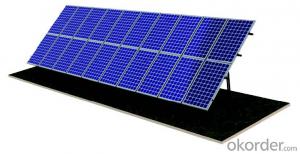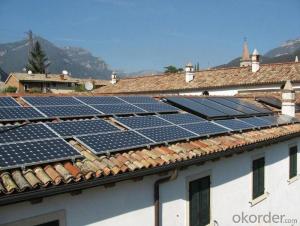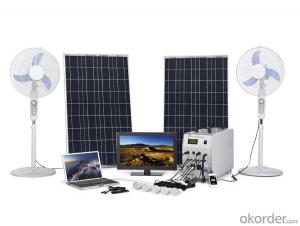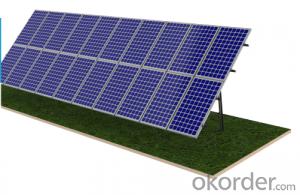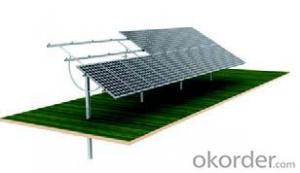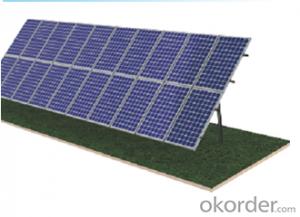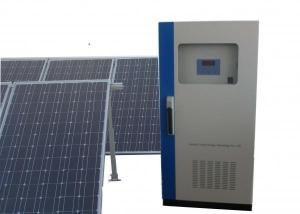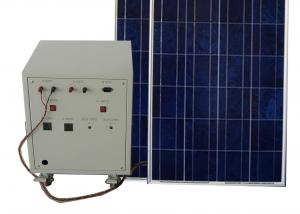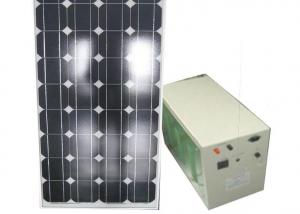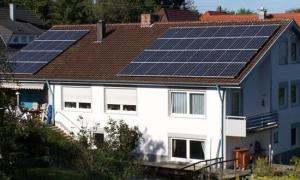Gadhia Solar Energy Systems - Single Pile Ground System
- Loading Port:
- China Main Port
- Payment Terms:
- TT OR LC
- Min Order Qty:
- -
- Supply Capability:
- -
OKorder Service Pledge
OKorder Financial Service
You Might Also Like
Packaging & Delivery
Packaging Detail:Normal package seaworthy
Delivery Detail:15 days
Specifications
Easy installation Competitive price TUV&SGS test report & CSA certification 15-warranty
Specifications
1) Super smooth beautiful appearance,outstanding quality,large supply.
2) Available in customized surface finishes.
3) Well machined,for example,cutting,drilling and milling with excellent tolerance.
4) Meet with customer’s designs and supply you best price.
5)Usages:Supply for solar panel modules.
Technical characteristics
Installation site:
ground,hillside,and grassland
Installation angle
it is based on customers’ requirements
Installation height
it is basedon customers’ requirements
Solar panel type; with or without frame
Components arrangement :horizontal or vertical
Support track
aluminum alloy extrusion
Quality warranty
15 years
Advantages
1)Quick installation: with high degree of pre-installed rate, the system could be easily installed by using galvanized carbon steel rails for PV Stent, and specially designed connection parts of the PV bracket, which could reduce installation time and cost greatly.
2)Offer unmatched durability: with all structural components comprised of high class stainless steel and anodized aluminum alloy, it is designed for 25 years service life and backed by 15 years warranty.
3)Stand up to extreme weather: The SuninTek solar mount is designed to stand up to the extreme weather complied with the AS/NZ 1170 and other international structure load standard by the skilled engineer. The main support components also have been tested to guarantee its structure and load-carrying capacity.
4)Provide broad installation flexibility: These systems accommodate most commercially available framed solar panels , and they can scale easily from small to large, multi-megawatt installations.
5)Diversified Application: The PV mounting system produced can be adopted by various types of PV cells panels which you can find in the market. It can serve for both mini solar power system and huge plant with megawatt capability.
Main features
1. Installation cost savings.
2. Save installation time.
3. Increase the mechanical strength of solar energy mounting to ensure that wind requirements.
4. The outdoor for installation of solar energy.
5. Length can be customized according to customers.
6. Service life of up to 25 years.
7. Products through the international certification.
8. Stent material composition of the galvanized steel and aluminum.
9. 15 years system and structural guarantee.
10.Flexible post spacing withstands different wind & snow loads.
11. High quality material in Aluminium 6005-T5 and SUS 304.
12.Screws and nuts go with every components needed.
13.Mechanical calculation and reliability tested to ensure highest product quality.
- Q: What is the role of batteries in off-grid solar energy systems?
- The role of batteries in off-grid solar energy systems is to store the excess electricity generated by the solar panels during the day for use during the night or when the sun is not shining. Batteries act as a backup power source, ensuring a continuous supply of electricity and enabling self-sufficiency in remote locations or during power outages. They provide a means to store and deliver the solar energy efficiently, making off-grid solar systems more reliable and independent.
- Q: Can a solar energy system be installed on a hospital or healthcare facility?
- Yes, absolutely. Solar energy systems can be installed on hospitals or healthcare facilities. In fact, many hospitals and healthcare facilities are adopting solar energy as a sustainable and cost-effective solution to meet their energy needs. These systems can provide clean and renewable energy, reducing the facility's carbon footprint and operating costs. Additionally, solar energy installations can help hospitals maintain a reliable power supply during emergencies or power outages, ensuring uninterrupted patient care.
- Q: Can solar energy systems be used for powering medical equipment in remote areas?
- Yes, solar energy systems can be used for powering medical equipment in remote areas. Solar power is a reliable and sustainable source of energy that can be harnessed to generate electricity for operating medical equipment even in areas with limited or no access to the electrical grid. This is particularly crucial in remote areas where infrastructure and power supply may be inadequate. Solar energy systems can provide a cost-effective and environmentally friendly solution, ensuring that essential medical equipment is powered and healthcare services can be delivered effectively.
- Q: Can solar energy systems be used for powering electric vehicle taxi services?
- Yes, solar energy systems can definitely be used for powering electric vehicle taxi services. Solar energy is a renewable and sustainable source of power that can be harnessed through the installation of solar panels. These panels convert sunlight into electricity, which can then be used to charge the batteries of electric vehicles used for taxi services. By utilizing solar energy systems, taxi operators can greatly reduce their dependence on traditional electricity grids and fossil fuels. This not only helps in reducing greenhouse gas emissions but also lowers the operating costs of running electric vehicle taxi services. Solar energy systems can be installed on the rooftops of taxi service stations or on the premises of charging stations. The excess energy generated during the day can be stored in batteries for later use during the night or on cloudy days when sunlight is scarce. Additionally, solar energy can be used to power the infrastructure required for electric vehicle taxi services. This includes charging stations, dispatch systems, and other operational equipment. By integrating solar power into these systems, taxi service providers can further enhance the sustainability and reduce their carbon footprint. However, it's important to note that the size of the solar energy system should be carefully planned to meet the energy demands of the electric vehicle taxi fleet. Factors such as the number of vehicles, distance traveled, and the availability of sunlight should be considered in determining the appropriate size of the solar energy system. In conclusion, solar energy systems can indeed be used to power electric vehicle taxi services. They offer a sustainable and cost-effective solution that reduces reliance on traditional energy sources and helps in mitigating climate change.
- Q: Are there any risks of electrical shock with solar energy systems?
- Yes, there are potential risks of electrical shock associated with solar energy systems. While solar panels themselves do not produce dangerous voltages, the electrical wiring and components used in the system can carry high voltages that may pose a risk if not handled correctly. It is crucial to have trained professionals install and maintain solar systems to ensure proper grounding, insulation, and safety precautions are in place, reducing the risk of electrical shock to a minimum.
- Q: Can solar energy systems be used for powering off-grid recreational vehicles?
- Yes, solar energy systems can indeed be used for powering off-grid recreational vehicles. Solar panels can be installed on the roof of the RV to capture sunlight and convert it into electricity. This renewable energy source can then be used to power various appliances, lights, and other electrical devices within the vehicle. It provides a reliable and environmentally friendly solution for RV owners seeking to go off-grid and reduce their dependence on traditional power sources.
- Q: Can solar energy systems be installed on airports or transportation hubs?
- Yes, solar energy systems can be installed on airports or transportation hubs. In fact, many airports around the world have already embraced solar power as a clean and sustainable energy source. These systems can be installed on rooftops, parking lots, or even as ground-mounted arrays near the facilities. Solar energy can help airports and transportation hubs reduce their carbon footprint, lower energy costs, and contribute to a greener and more sustainable future.
- Q: Can solar energy systems be used in remote areas without access to the electricity grid?
- Yes, solar energy systems can be used in remote areas without access to the electricity grid. Solar panels can be installed to generate electricity from sunlight, which can then be stored in batteries for use during times when the sun is not shining. This allows off-grid communities in remote areas to have a reliable and sustainable source of electricity, reducing their dependence on traditional power sources and contributing to their overall development and well-being.
- Q: Can solar energy systems be installed in areas with extreme weather conditions?
- Solar energy systems can indeed be installed in regions with harsh weather conditions. Though extreme heat, cold, wind, or snow may potentially affect the efficiency of solar energy systems, modern solar technology has been engineered to endure such conditions. Solar panels are constructed using sturdy materials capable of withstanding high temperatures, freezing temperatures, and strong winds. Furthermore, solar panels undergo rigorous testing and certification to meet industry standards for durability and performance in various weather conditions. In areas with extreme heat, solar panels are designed to dissipate heat and maintain optimal efficiency. They are thoroughly tested to ensure they can sustain high temperatures without any damage or significant performance loss. Similarly, solar panels in areas with extreme cold are built to withstand freezing temperatures and can even generate electricity in snowy conditions. Some solar panels feature anti-reflective coatings to absorb more sunlight and expedite snow melting. Moreover, solar energy systems are commonly installed with robust mounting systems and structures capable of enduring strong winds or storms. These systems are engineered to ensure that solar panels remain securely attached to roofs or ground mounts, even in hurricane-prone or high-wind regions. Though the performance of solar energy systems may be slightly affected by extreme weather conditions, proper installation and design enable solar panels to still generate electricity and provide a dependable source of renewable energy in such areas. It is advisable to seek guidance from experienced solar installers or engineers who can evaluate the specific weather conditions of a given region and develop a solar energy system capable of withstanding those conditions.
- Q: How do solar energy systems affect the structural integrity of a building?
- Solar energy systems typically have minimal impact on the structural integrity of a building. The installation of solar panels involves mounting them on the roof or on supportive structures, which are designed to distribute the weight evenly and ensure stability. As long as the installation is carried out by professionals and follows proper engineering guidelines, solar energy systems should not pose any significant risks to the building's structure.
Send your message to us
Gadhia Solar Energy Systems - Single Pile Ground System
- Loading Port:
- China Main Port
- Payment Terms:
- TT OR LC
- Min Order Qty:
- -
- Supply Capability:
- -
OKorder Service Pledge
OKorder Financial Service
Similar products
Hot products
Hot Searches
Related keywords
